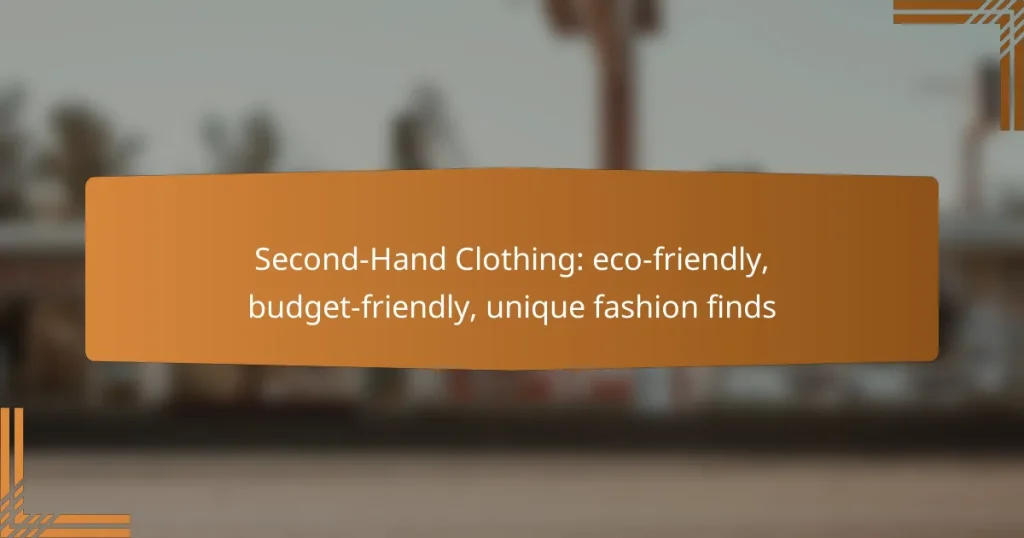Second-hand clothing is an excellent choice for those seeking eco-friendly and budget-friendly fashion options. With a variety of sources available, from online platforms to local thrift stores, shoppers can discover unique pieces that not only save money but also promote sustainability. By focusing on quality and condition, you can curate a wardrobe that reflects your personal style while making a positive impact on the environment.

Where to find second-hand clothing in the UK?
In the UK, second-hand clothing can be found in various places, including online platforms, local charity shops, thrift stores, and vintage boutiques. Each option offers unique selections and price points, making it easy to find eco-friendly and budget-friendly fashion.
Online marketplaces like Depop
Depop is a popular online marketplace where users can buy and sell second-hand clothing directly. It features a wide range of styles, from everyday wear to unique vintage pieces, often at lower prices than retail.
When using Depop, consider checking seller ratings and reviews to ensure a positive shopping experience. Look for items with clear photos and detailed descriptions to avoid surprises upon delivery.
Charity shops in London
London is home to numerous charity shops, which offer second-hand clothing at affordable prices while supporting various causes. Well-known chains like Oxfam and Cancer Research UK have multiple locations throughout the city.
Shopping at charity shops not only helps you find unique items but also contributes to charitable organizations. Be prepared to spend some time browsing, as inventory can vary widely from day to day.
Thrift stores in Manchester
Manchester boasts a vibrant thrift store scene, with many shops specializing in second-hand clothing. Stores like Thrift Shop Manchester and Pop Boutique offer a mix of contemporary and retro styles.
When visiting thrift stores, consider going during weekdays for a quieter shopping experience. Keep an eye out for sales or discounts, as many stores offer promotions that can help you save even more.
Vintage boutiques in Brighton
Brighton is known for its eclectic vintage boutiques, where you can find curated selections of second-hand clothing. Shops like Snoopers Paradise and Beyond Retro feature unique pieces that reflect the city’s artistic vibe.
Shopping at vintage boutiques can be a bit pricier than other second-hand options, but the quality and uniqueness of the items often justify the cost. Don’t hesitate to ask shop owners for styling tips or recommendations based on your personal style.
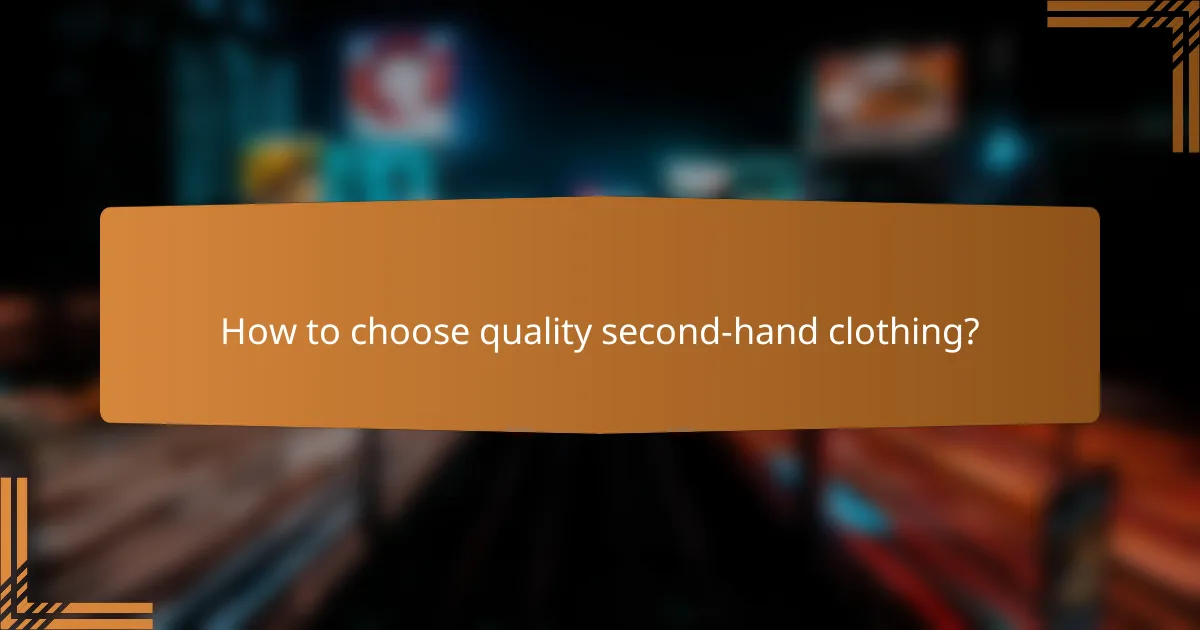
How to choose quality second-hand clothing?
Choosing quality second-hand clothing involves examining the fabric, construction, and overall condition of the items. By focusing on these aspects, you can find unique pieces that are both eco-friendly and budget-friendly.
Inspect fabric and stitching
Start by feeling the fabric; high-quality materials like cotton, wool, and silk tend to last longer. Look for well-stitched seams, as loose threads or uneven stitching can indicate poor craftsmanship.
Pay attention to the fabric weight as well. Heavier fabrics often indicate durability, while lighter materials may wear out more quickly. If possible, check for labels that indicate the fabric type and care instructions.
Check for signs of wear
Examine the clothing for any visible signs of wear, such as fading, pilling, or stains. Minor imperfections can sometimes be fixed, but significant damage may not be worth the investment.
Look closely at areas that typically show wear, like elbows, knees, and hems. If you find excessive wear in these spots, it may be a sign that the item won’t last much longer.
Know your sizes
Understanding your sizes is crucial when shopping for second-hand clothing, as sizing can vary significantly between brands and eras. Always try items on when possible, or check the measurements against a similar piece you own.
Keep a size chart handy, especially if you are shopping online. Knowing your measurements in centimeters or inches can help you make informed decisions and avoid returns.
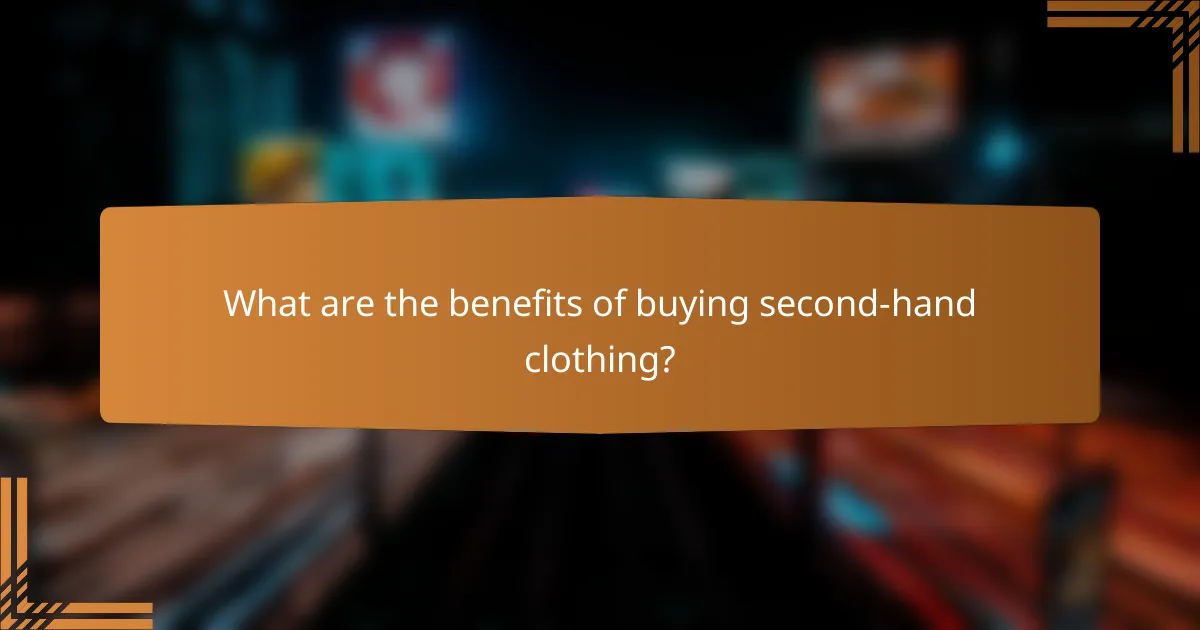
What are the benefits of buying second-hand clothing?
Buying second-hand clothing offers numerous advantages, including environmental sustainability, cost savings, and the opportunity to discover unique pieces. These benefits make it an appealing choice for many consumers looking to enhance their wardrobes responsibly.
Eco-friendly fashion choice
Second-hand clothing is an eco-friendly fashion choice as it helps reduce waste and the demand for new textile production. By purchasing pre-owned items, you contribute to a circular economy, minimizing the environmental impact associated with manufacturing and disposing of garments.
Additionally, the fashion industry is a significant contributor to pollution and resource depletion. Choosing second-hand options can significantly lower your carbon footprint, as it requires fewer resources and energy compared to buying new clothing.
Budget-friendly options
Second-hand clothing provides budget-friendly options that allow shoppers to save money while still enjoying stylish apparel. Prices for used clothing can often be a fraction of the original retail price, making it accessible for those on a tight budget.
Thrift stores, consignment shops, and online marketplaces frequently offer discounts on quality items. Shoppers can find everything from everyday wear to designer pieces at reduced prices, often ranging from 30% to 70% off retail value.
Unique fashion finds
Shopping for second-hand clothing opens the door to unique fashion finds that you won’t typically encounter in mainstream retail stores. Vintage and rare pieces can add character and individuality to your wardrobe, allowing you to express your personal style.
Exploring thrift shops and online platforms can yield one-of-a-kind items that reflect different eras and trends. This not only enhances your fashion collection but also supports sustainable practices by giving these garments a new life.
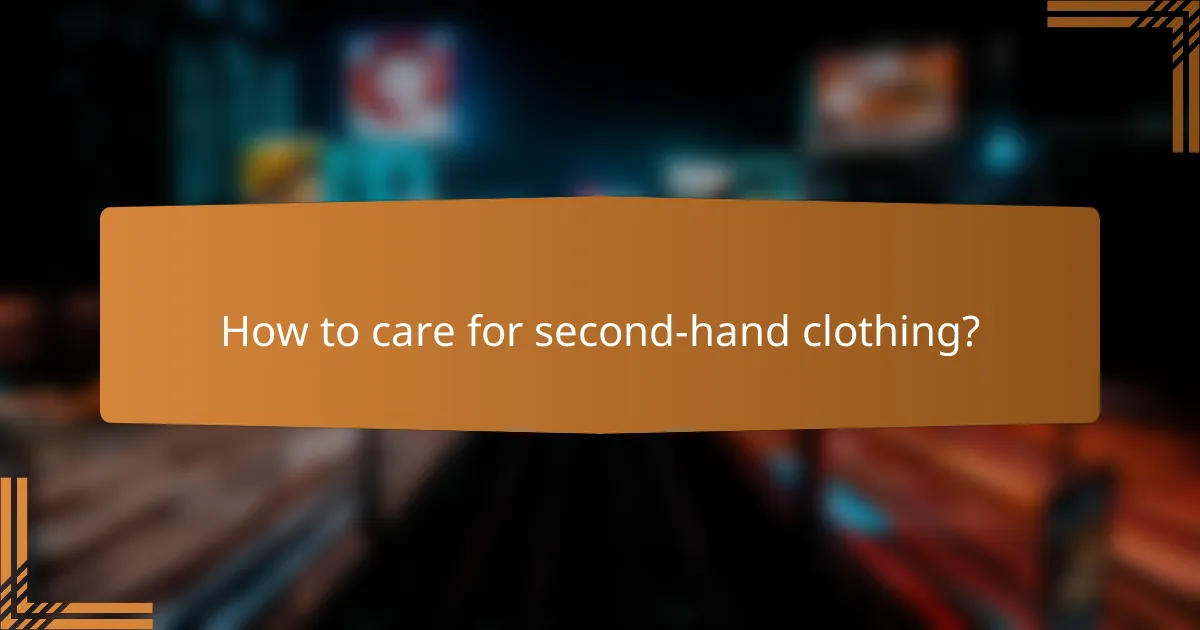
How to care for second-hand clothing?
Caring for second-hand clothing involves specific techniques to maintain its quality and extend its lifespan. Proper washing, storage, and handling can help preserve unique fashion finds while being eco-friendly and budget-conscious.
Proper washing techniques
When washing second-hand clothing, always check the care label for specific instructions. Use cold water and a gentle detergent to minimize wear and fading. For delicate fabrics, consider hand washing or using a mesh laundry bag to protect them in the machine.
Avoid using bleach or harsh chemicals, as these can damage the fibers. Instead, opt for natural stain removers like baking soda or vinegar for tough spots. Washing items less frequently can also help maintain their condition.
Storage tips for longevity
Storing second-hand clothing properly is crucial for preserving its quality. Use breathable garment bags or cotton storage bins to protect against dust and moisture. Avoid plastic bags, as they can trap humidity and lead to mold or mildew.
For hanging items, use padded or wooden hangers to prevent stretching and maintain shape. Fold heavier garments like sweaters to avoid stretching the shoulders. Keep items in a cool, dry place away from direct sunlight to prevent fading and deterioration.

What are the best brands for second-hand clothing?
Some of the best brands for second-hand clothing include Patagonia, Levi’s, and Dr. Martens. These brands are known for their quality, sustainability, and unique styles, making them popular choices for eco-conscious and budget-friendly shoppers.
Patagonia for sustainable options
Patagonia is renowned for its commitment to sustainability and environmental responsibility. When shopping for second-hand Patagonia items, look for their signature recycled materials and Fair Trade Certified products, which ensure ethical production practices.
Consider checking online platforms like Poshmark or ThredUp, where you can find a range of Patagonia gear, from jackets to activewear. Prices typically range from $30 to $150, depending on the item and condition.
Levi’s for vintage denim
Levi’s is a go-to brand for vintage denim lovers. Their jeans are known for durability and style, making them a staple in many wardrobes. When buying second-hand Levi’s, pay attention to the label, as vintage pairs often have unique cuts and washes that are no longer in production.
Thrift stores and online marketplaces like eBay often have a wide selection of Levi’s jeans, with prices generally between $20 and $80. Look for classic styles like the 501 or 505 for timeless appeal.
Dr. Martens for footwear
Dr. Martens offers iconic footwear that combines style and comfort. Their boots and shoes are made to last, making them a smart choice for second-hand purchases. When searching for Dr. Martens, check for the quality of the leather and the condition of the soles to ensure longevity.
Second-hand Dr. Martens can be found at thrift shops or online retailers like Depop, with prices usually ranging from $40 to $120. Opt for classic styles like the 1460 boots for a versatile addition to your wardrobe.
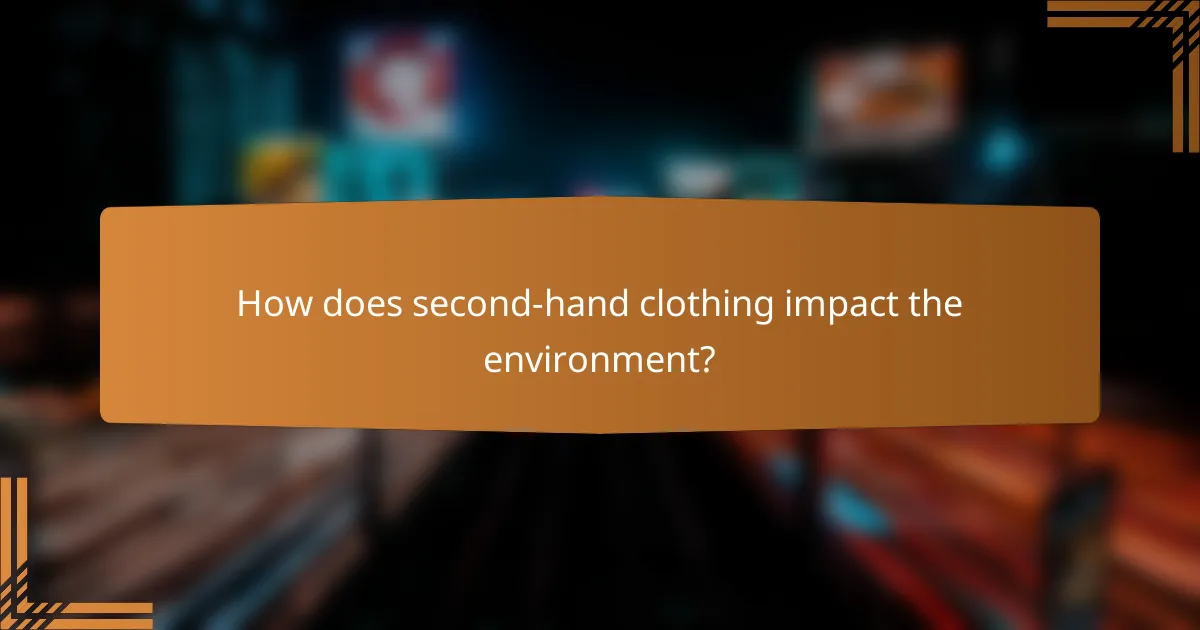
How does second-hand clothing impact the environment?
Second-hand clothing significantly reduces environmental impact by minimizing waste and conserving resources. By choosing pre-owned garments, consumers help decrease the demand for new clothing production, which is resource-intensive and contributes to pollution.
Reduction of textile waste
Purchasing second-hand clothing directly contributes to the reduction of textile waste. The fashion industry is one of the largest contributors to landfill waste, with millions of tons of clothing discarded each year. By opting for used items, individuals can extend the life cycle of garments and keep them out of landfills.
Conservation of resources
Second-hand clothing helps conserve valuable resources such as water, energy, and raw materials. Producing new clothing requires significant amounts of water and energy, often leading to environmental degradation. By choosing second-hand, consumers reduce the demand for these resources, promoting a more sustainable fashion cycle.
Lower carbon footprint
The carbon footprint associated with second-hand clothing is generally lower than that of new garments. The production and transportation of new clothing contribute to greenhouse gas emissions. In contrast, buying used clothing typically involves less energy consumption and fewer emissions, making it a more eco-friendly choice.
Support for local economies
Buying second-hand clothing often supports local businesses and charities, fostering community growth. Thrift stores and consignment shops frequently reinvest profits into local initiatives, creating a positive economic impact. This not only promotes sustainability but also strengthens community ties.
